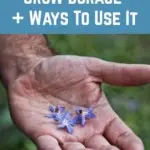
Borage is often mentioned in organic gardening circles. It is considered by many to be a wonderful plant, which can find pride of place in many gardens.
But what exactly is so great about this plant? What is borage? What are the reasons to grow it in your garden?
And how exactly should you use it in your garden (and once it is harvested)? Read on to find out.
What is Borage?
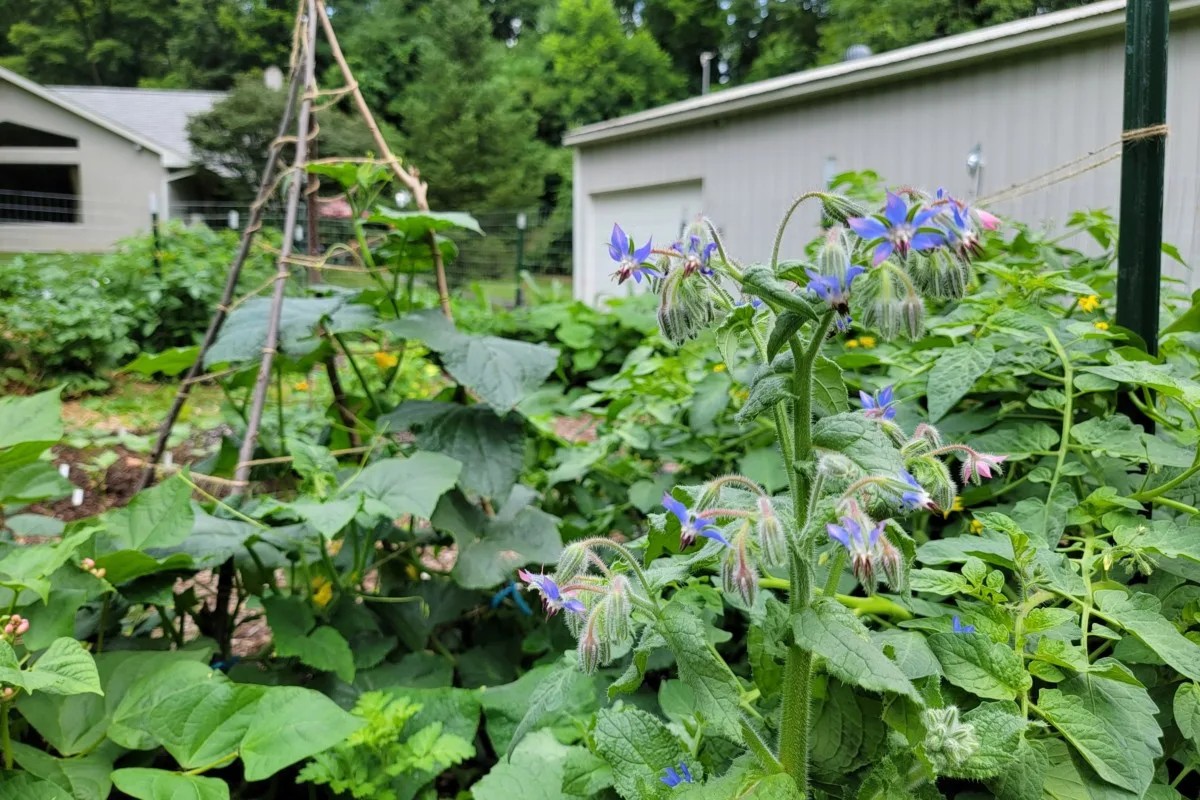
Borage is the common name for Borago officinalis. It is also known as starflower.
This is an annual flowering plant. It flowers from around June right through to October in most temperate climates, and grows to around two feet in height at a medium rate.
In warmer climes it may even bloom almost continuously for most of the year.
Borage is native to the Mediterranean region and has naturalized elsewhere. It grows very well in gardens across Europe and is also common in kitchen gardens across North America.
The plant is hairy all over its stems and leaves. The flowers are star-like, with five, narrow, triangular-pointed petals.
These beautiful flowers are generally blue, though pink flowers are occasionally also observed, and there are also white-flowered cultivars.
The flowers are generally a deeper blue when the plants are grown in poorer soil conditions.
Borage is relatively unfussy when it comes to growing conditions.
It can cope with almost all soil types, including soils low in nutritional content. The plant can also cope with a range of soil pH levels, even very alkaline soils.
It can survive with very free-draining soils and is relatively drought tolerant. And can be grown in full sun, or light or dappled shade.
Borage is best grown from seed. Sow seeds under cover and plant them out once weather has begun to warm, or direct sow seeds where they are to grow after the last frost date in your area.
Sow once, this annual will then readily self-seed if left to its own devices.
Why Grow Borage in Your Garden?
There are a great many reasons why you should consider growing borage in your garden. It is useful both while it is in growth, and as a crop for harvesting.
Here are just 15 reasons to grow borage in your garden:
1. Borage is an Edible Crop
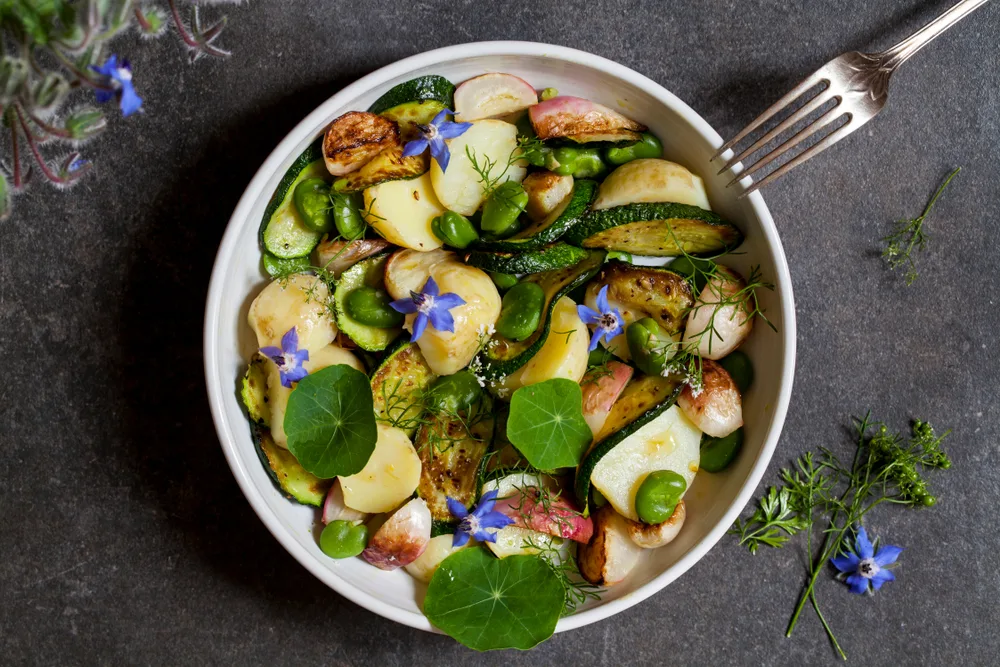
One of the main reasons to grow borage in your garden is as an edible crop.
You can eat the leaves, raw or cooked, and the flowers, raw, as a garnish or in drinks. The dried stems can also be used for flavouring, and the seeds yield an oil that is particularly high in gamma-linolenic acid.
We’ll talk a little more about how you can use borage as an edible crop a little later in this article.
Not only does it taste great, it is also a common ingredient in herbal medicine, and can be great for your health.
A couple of caveats to mention, however: people with liver problems would be best to avoid eating these plants.
And no one should make borage a major part of their diet, as it does contain small quantities of pyrrolizidine alkaloids in tiny quantities.
That said, you will generally find that borage is a useful addition to your home-grown diet.
2. Borage Looks Beautiful
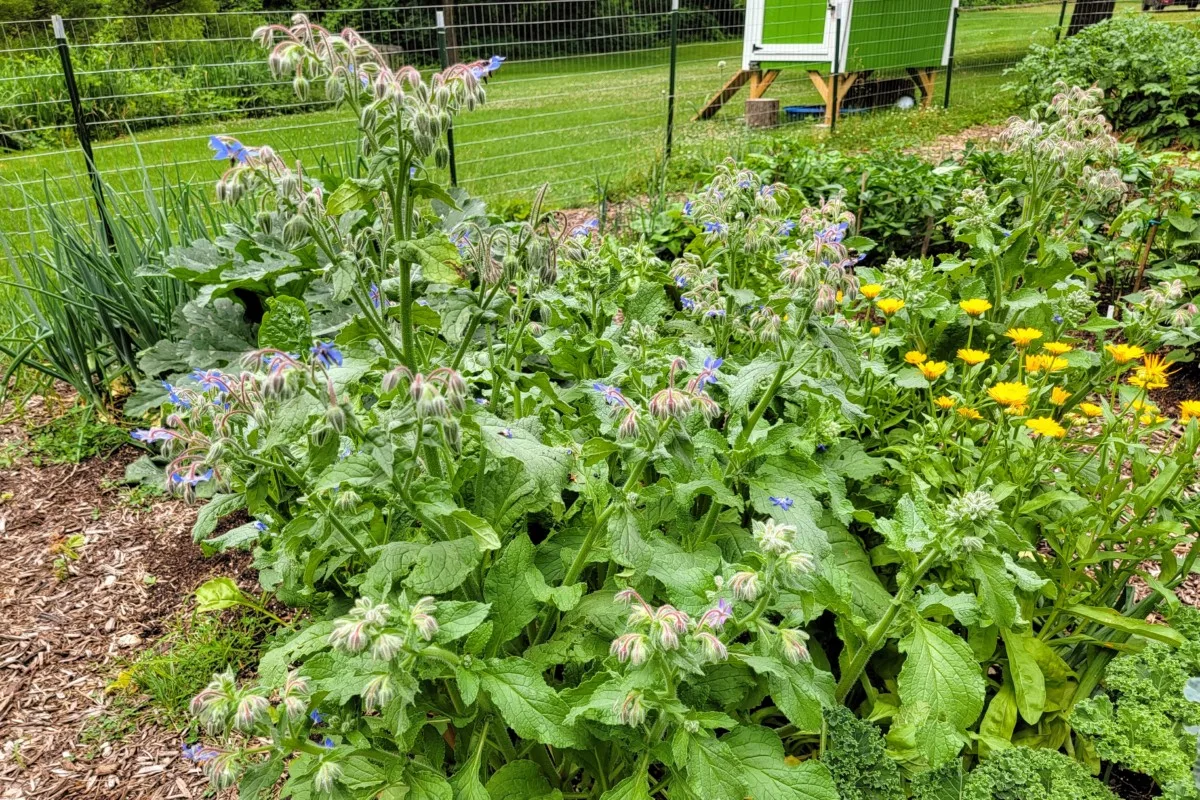
Wherever you choose to grow it, borage is beautiful as well as useful.
Blooming over a long portion of the year, borage can bring a cheery splash of blue to your garden. Its delicate flowers stand out against a sea of green, and can add to the visual amenity of your space.
They can add floral beauty to:
- Your vegetable beds or kitchen garden.
- Dedicated herb gardens.
- A fruit tree guild.
- Planting areas around fruit bushes or fruiting canes (or largely perennial polycultures).
- An ornamental bed or border in your garden.
3. It Self-Seeds Readily So Pops Up Year After Year
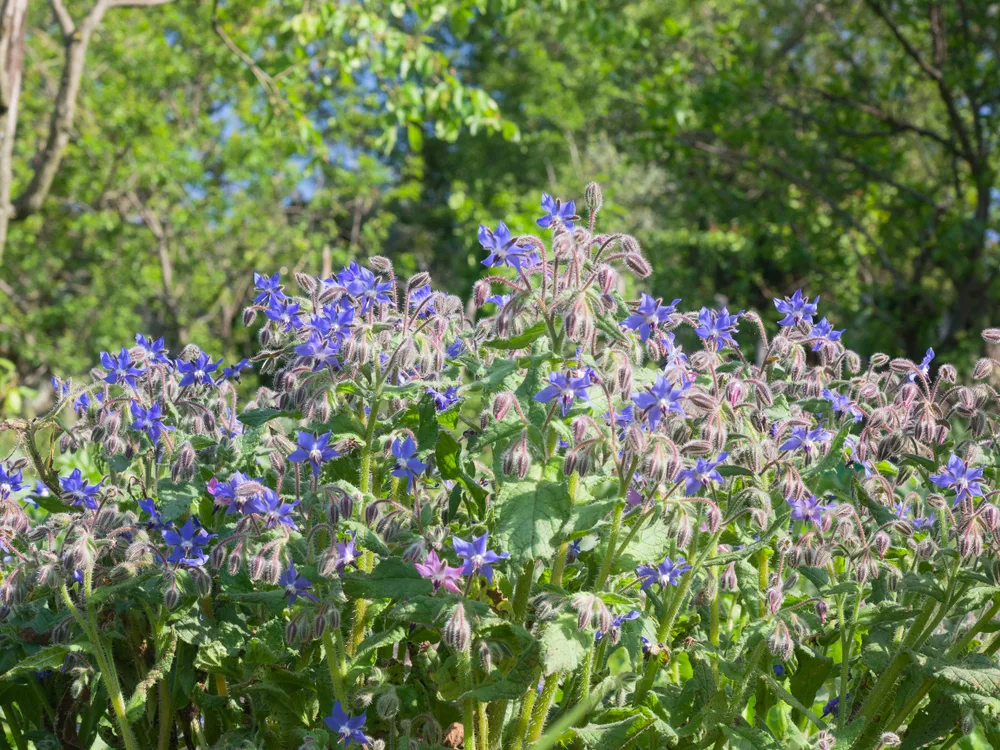
One of the interesting things about borage is that, even though it is an annual, it will generally, once planted, remain in your garden for years.
Borage, when left to set seed, will generally self-seed very readily.
So once you have planted some in your garden, you should find that it seeds itself and pops up all around your growing areas year after year.
While self-seeding plants are not always ideal for very neat and tidy gardeners, borage is such a useful plant that gardeners are often happy to let it naturalize around their gardens.
It is worthwhile remembering that self-seeding annuals and a good mixture of perennial plants are ideal for a low-maintenance garden.
So borage can be a great choice for those with limited time, who want to create a garden where there is less to do each year.
Read Next: 18 Self Seeding Flowers, Herbs & Veggies For The Lazy Gardener
4. Borage is a Dynamic Accumulator
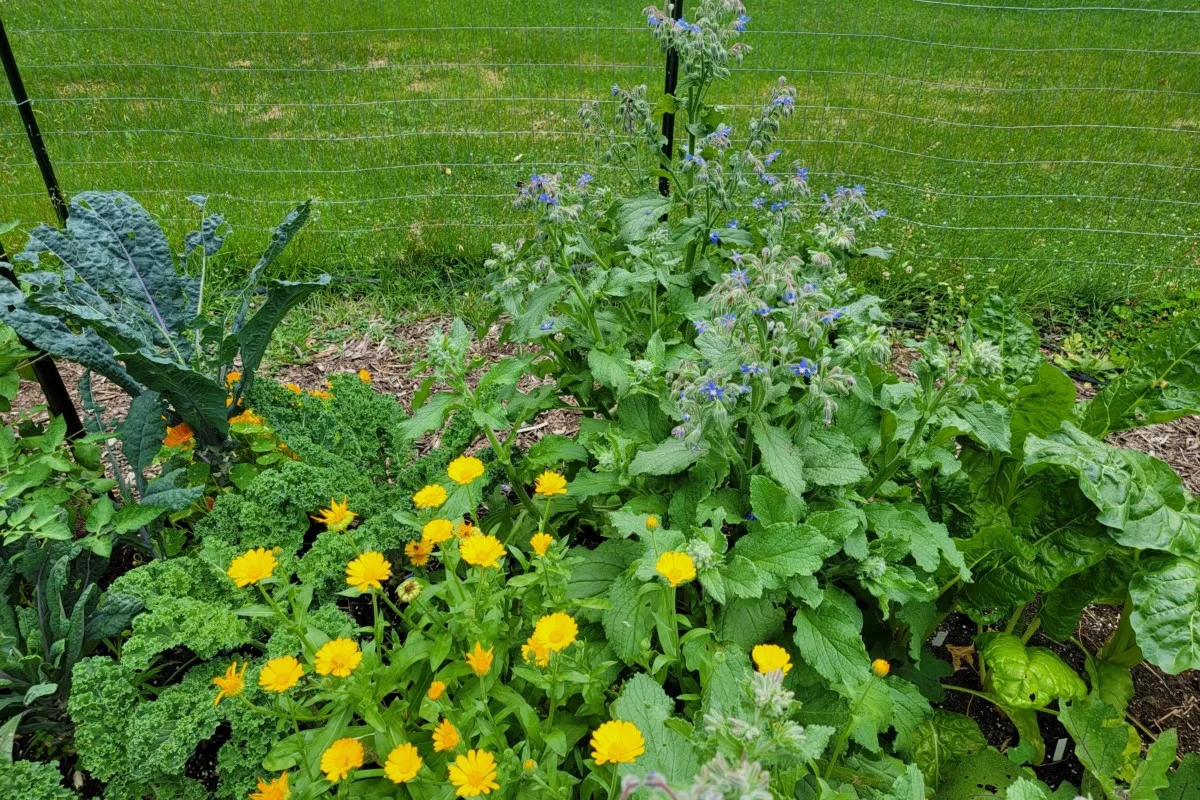
Borage has the ability to dynamically gather nutrients from the soil. This can help reduce nutrient leaching and make sure that nutrients are gathered and stored.
Borage is said to be particularly beneficial in accumulating potassium.
While scientific evidence on dynamic accumulation is often scant, it could be worthwhile considering borage in this capacity.
5. So It Can Also Be Great as Mulch
Since borage captures and stores nutrients (such as potassium) effectively from the soil, it can be beneficial when chopped and dropped around other garden plants as mulch.
Borage can be beneficial as a mulch around a range of common crops, and may be particularly beneficial for flowering and fruiting plants.
Mulching with organic plant material adds to the nutrients available in the soil for the uptake of other plants.
It also improves the soil quality, reduces weeds, and aids in water retention.
6. Or On The Compost Heap
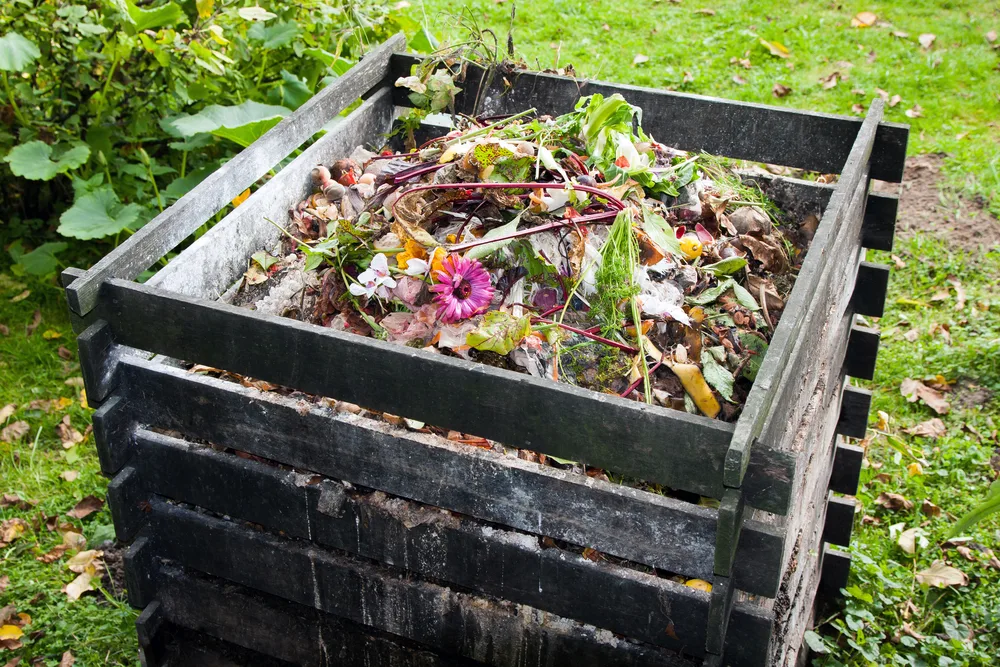
As chopped plants, you can also add borage to your compost heap or other composting system.
As a nitrogen rich green material, which is also high in potassium and other essential plant nutrients, borage can help all the materials in the heap to break down.
Adding borage to your compost heap can also help make sure you have a nutrient-rich and well balanced compost at the end of the process.
7. Or When Used To Make a Liquid Fertilizer for Your Plants
Another way to use chopped borage is to make your own liquid fertilizer or liquid plant feed for your growing areas.
Liquid fertilizers can be made using a range of different weeds and garden plants. They can give your crops a quick boost and help maintain fertility in your growing areas.
You can use borage alone, or combine it with other weeds from your garden for a nutrient rich weed tea that provides other plants with a wider range of different nutrients.
10 Liquid Fertilizers Made From Weeds & Plants @ RuralSprout.com
8. Borage Helps Break Up and Aerate the Soil
This plant’s roots have a simple structure, but the way in which they penetrate the soil can help to break it up and aerate it.
Borage, therefore, can be a good choice in regions prone to compaction.
A cover crop of borage could help to improve the soil quality before other crops are grown.
And by self-seeding prolifically, borage can help to cover areas of bare soil and fill in patches in your growing areas.
The more you can cover soil, the more you will protect the fragile and essential ecosystem it contains.
9. Borage is Great for Bees
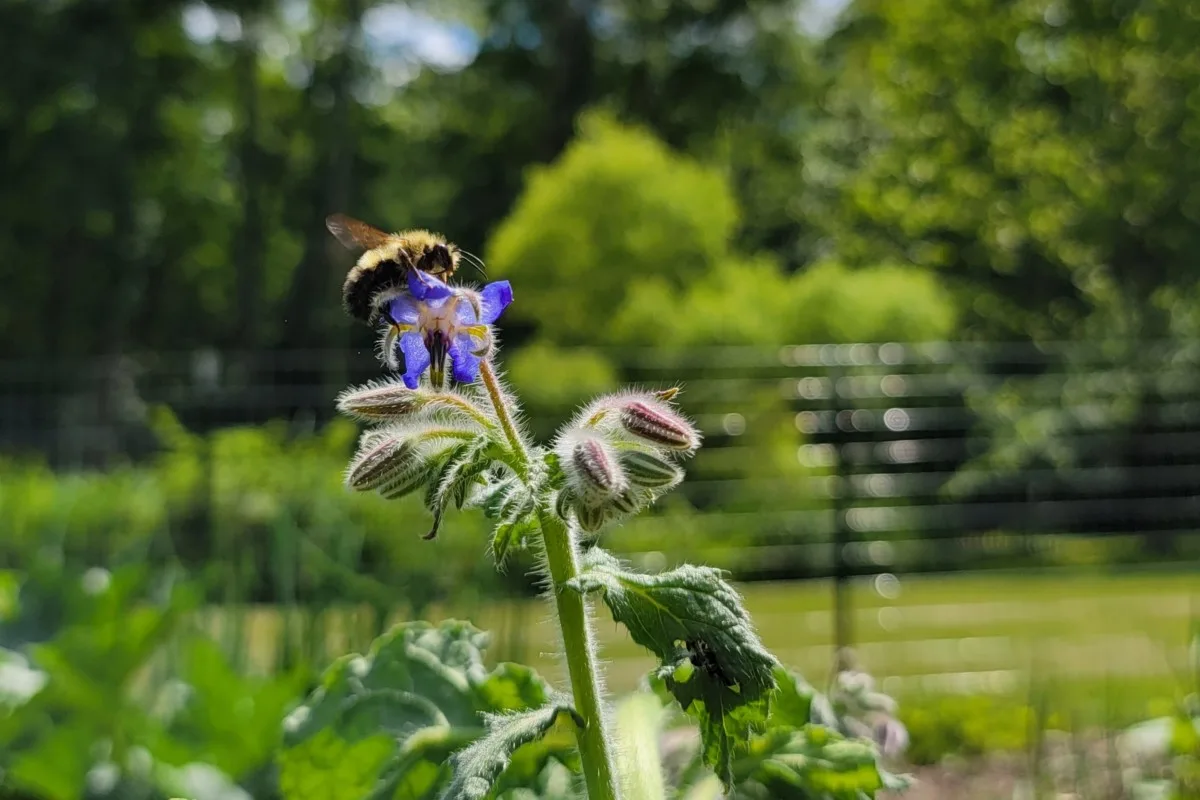
But perhaps the most important function borage fulfils in a garden is as a boon to bees and other pollinators.
We are currently in a worrying period of mass extinction.
Many bee species and other pollinating insects are endangered. Without these insects, we would not be able to grow much of our food without immense effort.
It is vital that we protect biodiversity whenever we can.
As gardeners and growers, one of the things we can do is make sure we have flowers in bloom for pollinators throughout the year.
Since borage can be in bloom over such a long season, it is a particularly beneficial bee-friendly plant. Bees are also attracted to borage flowers in preference to those of many other plants.
Bees tend to be attracted to purple/ blue flowers, and the simple structure of borage flowers means that the nectar is easy for bees and other pollinators to access.
10. So It Also Aids in Effective Pollination
What is great for the bees is great for the gardener or grower too.
By planting bee-attractant plants like borage, we can make sure that pollinators are around to pollinate our crops.
Many of the common plants we grow depend on insects for pollination. So planting borage close to those plants can make a big different to the yields that we get.
The pollinator attracting properties of borage are one of the main reasons why it makes such a great companion plant for a range of crops.
To aid pollination, borage can be a great addition all around your property.
11. It’s Also a Trap Crop for Aphids
But there are also other reasons why borage is such a good companion plant. One other great thing about borage is that it attracts aphids.
You may not immediately think of this as a good thing. But since it draws aphids to it, this plant can serve as a useful trap crop.
Aphids will be drawn preferentially to your borage, which can keep them away from your other crops.
12. And All Those Aphids Attract Other Beneficial Insects
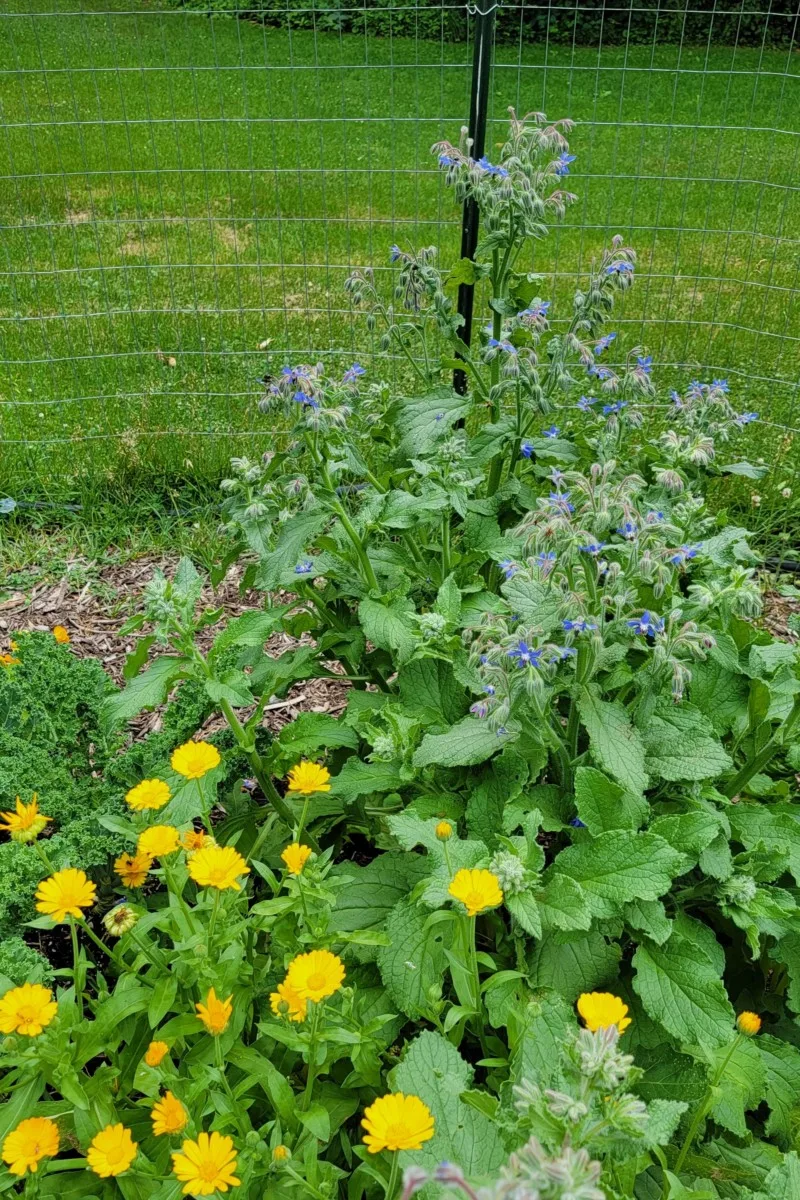
Another thing to consider is that since they attract aphids and other pest species, they also attract a range of other, more beneficial insects.
Insects like ladybugs and lacewings that prey on aphids will be drawn to their food source.
And having these beneficial bugs in your garden can help maintain a balance in the garden ecosystem overall.
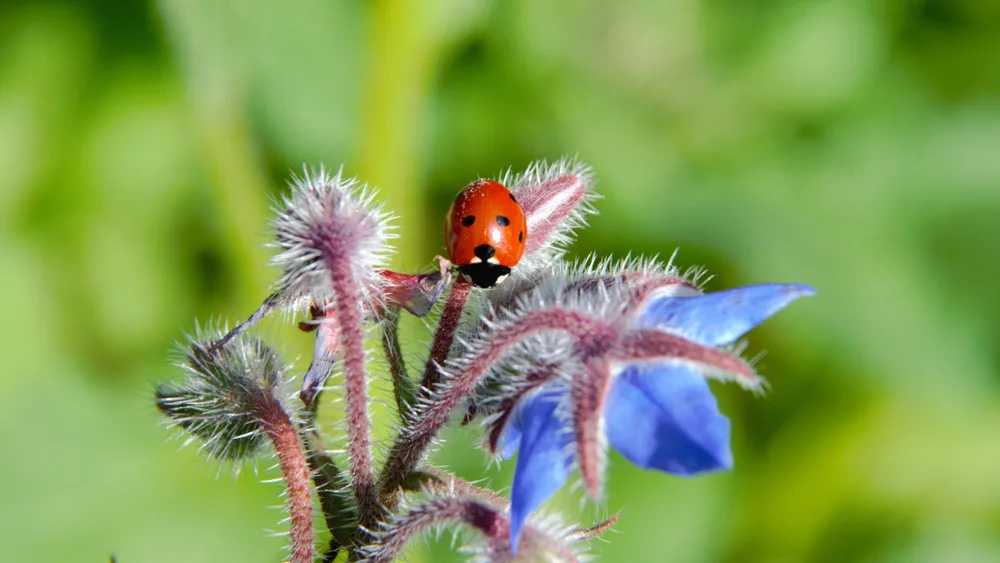
13. It May Also Deter Certain Pests
While the evidence is largely anecdotal, some gardeners swear that borage can also repel or deter certain pests, such as tomato hornworm, and cabbage moths, for example.
Whether or not borage really does repel these pests, it could be worth a try planting it as a companion plant for vulnerable crops.
Even if it does not actually repel these pests, borage will still have the other benefits mentioned on this list.
14. Borage is Great for Birds Too
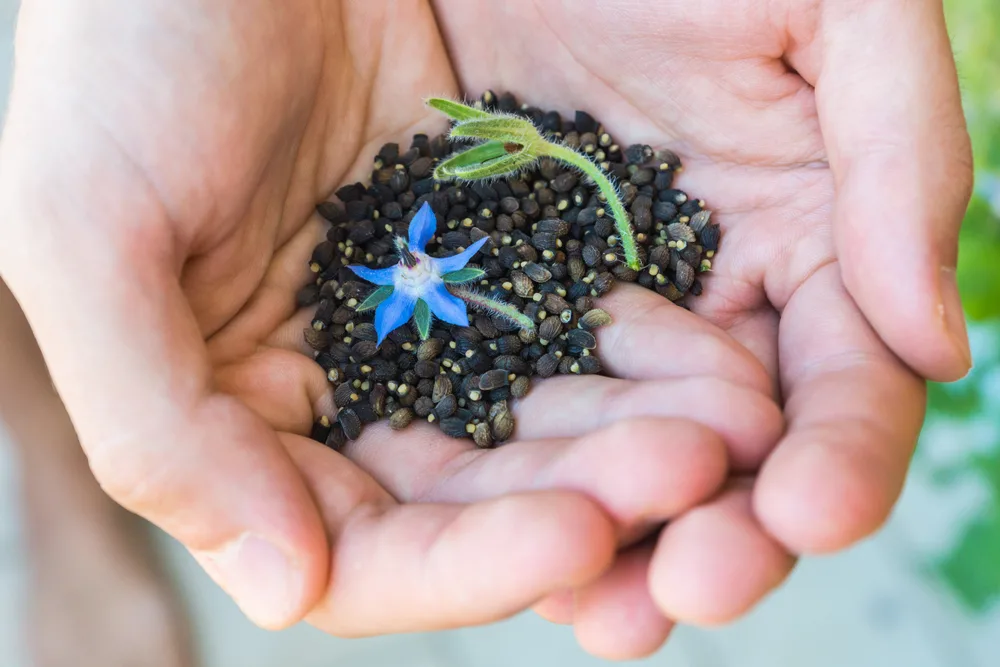
Once borage goes to seed, the seed also provides food for a range of creatures, including a number of seed-eating bird species, such as finches.
Attracting birds to your garden will help keep the ecosystem in balance, and help maintain a healthy biodiversity in your garden.
15. Including Backyard Chickens
And wild birds are not the only creatures which could benefit. Your feathered backyard flock will also enjoy eating borage.
It can be a useful addition to your hens’ foraged diet, or can be chopped and tossed into their run to give your chickens a healthy treat.
Companion Planting With Borage
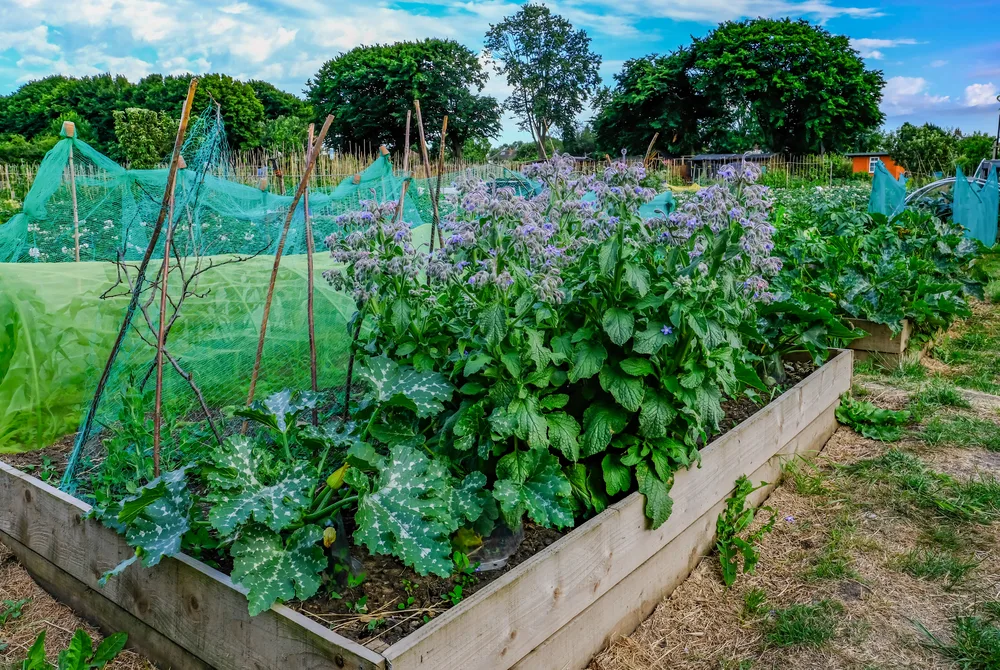
So, now you have a much better idea of the reasons to grow borage in your garden, let’s take a little time to explore in a little more depth how you might use it.
The first and most common way to use borage in your garden design is as a companion plant.
Borage is a common companion plant for a wide range of different fruits and vegetables.
In fact, borage can be a good ‘nurse’ plant throughout your garden, and works well with almost any plant.
In particular, for some of the reasons mentioned above, borage is said to be a particularly good companion plant for:
- Cabbages (and other brassicas)
- Beans
- Cucumber
- Fruit trees (and fruit bushes and canes)
- Squash
- Strawberries
- Tomatoes
For example, borage might be included as part of a polyculture with tomatoes and squash, as in the link below.
A Companion Planting Trio @ thespruce.com
Using Borage in Crop Rotation/ As a Cover Crop
Another way to incorporate borage into your garden plan is to use it as a green manure or cover crop, which gathers nutrients, protects the soil and attracts beneficial wildlife before being chopped and dropped to feed the soil ready for the next crop in rotation.
Using Borage as an Edible Crop
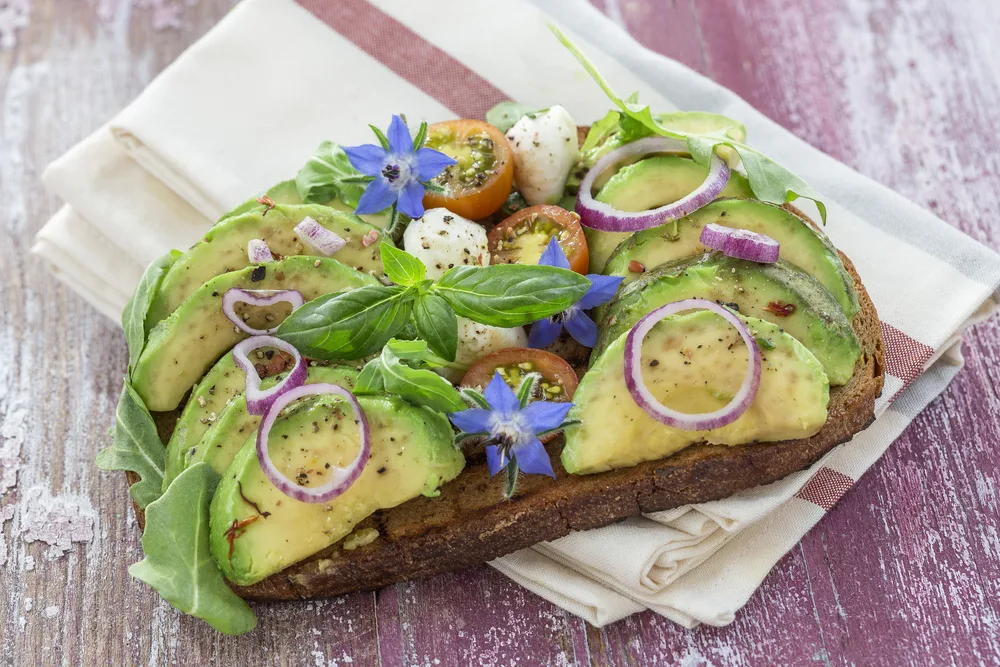
Borage is such a useful plant in the garden, while growing and when harvested, that you may not immediately turn your attention to its uses elsewhere on your homestead.
But whatever else you choose to do with it, it is worthwhile keeping a few plants aside to use in your kitchen.
As mentioned above, borage can also be a useful edible crop. So how can be use it?
Here are a few examples demonstrating the different ways that the leaves and flowers can be used:
Borage Recipes
Mixed Herb Salad With Borage @ food.com.
Cucumber Salad With Borage Flowers @ allrecipes.com.
Cucumber and Borage Canapés @ growntocook.com.
Sandwiches @ food.com.
Borage Cucumber Salad Dressing @ tasteofhome.com.
Raita @ sophies-table.com.
Pasta With Borage @ eatsmarter.com.
Quiche @ ladittatrice.wordpress.com.
Borage Leaf, Pea and Mint Soup @ theseasonaltable.co.uk.
What is more, borage is also used in a number of different drinks. It is a common garnish for the UK drink ‘Pimms’ and for lemonade.
For cool cocktails in summer, you can freeze borage flowers in ice cubes then add them to your beverages.
Borage is also used to make a soothing tea.
Traditionally, borage tea is used as a herbal remedy for depression and melancholia.
In herbal medicine, an infusion is taken internally to treat fevers, chest problems and kidney problems.
It is also used in the regulation of female cycles and to promote good heart health. (Though if you plan on using herbal remedies on a regular basis, it is always best to work with a qualified herbal medicine practitioner.)
Other Uses for Borage
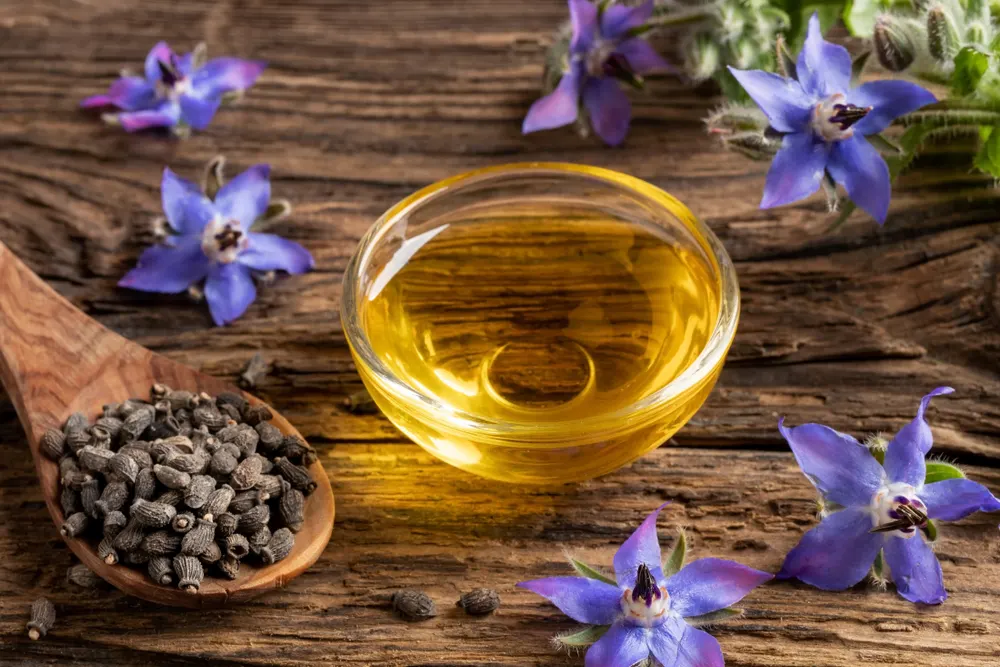
Borage is also used externally in herbal medicine to treat inflammatory swellings. You can make a poultice to sooth the skin.
Borage Poultice @ herbclass.com.
If the seeds are harvested, these can be used to create borage oil, which is extremely rich in gamma-linolenic acid (an essential fatty acid) also known as vitamin F. Borage oil has been shown to have a beneficial effect for those suffering from rheumatoid arthritis.
Borage oil can also be used in making soap, and in making a range of other skin care products. You can also simply add a few leaves or flowers to a number of other soap recipes, such as the one below:
Cucumber and Borage Soap @ thenerdyfarmwife.com.
Finally, borage flowers can be used to make a dye – either for edible recipes, or for dyeing fabric. The flowers work especially well for blue dyes when frozen.
As you can see, there are plenty of reasons to give borage some space in your garden.
So why not get some seeds and plant some in your garden this spring?

Get the famous Rural Sprout newsletter delivered to your inbox.
Including Sunday ramblings from our editor, Tracey, as well as “What’s Up Wednesday” our roundup of what’s in season and new article updates and alerts.


